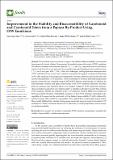Por favor, use este identificador para citar o enlazar a este item:
http://hdl.handle.net/10261/332525COMPARTIR / EXPORTAR:
 SHARE SHARE
 CORE
BASE CORE
BASE
|
|
| Visualizar otros formatos: MARC | Dublin Core | RDF | ORE | MODS | METS | DIDL | DATACITE | |

| Título: | Improvement in the stability and bioaccessibility of carotenoid and carotenoid esters from a papaya by-product using O/W emulsions |
Autor: | Lara-Abia, Sara CSIC ORCID; Lobo-Rodrigo, Gloria; Pérez-Pascual, Noelia; Welti-Chanes, Jorge; Cano, M. Pilar CSIC ORCID | Palabras clave: | Carica papaya L. By-products Carotenoids O/W emulsions Encapsulation Vegetable oils Stability Bioaccessibility Emulsion microstructure |
Fecha de publicación: | 10-jul-2023 | Editor: | Multidisciplinary Digital Publishing Institute | Citación: | Foods 12(14): 2654 (2023) | Resumen: | The aim of the present work was to improve the stability and bioaccessibility of carotenoids from green oil extracts obtained from papaya by-products using oil-in-water (O/W) emulsions. The effects of different concentrations of pectin (1%, 2%, and 3%), a high-molecular-size emulsifier, together with Tween 20, a low-molecular-size emulsifier, high-speed homogenization conditions (time: 2, 3, 4, and 5 min; rpm: 9500, 12,000, 14,000, and 16,000 rpm), and high-pressure homogenization (HPH) (100 MPa for five cycles) were evaluated to determine the optimal conditions for obtaining O/W stable emulsions with encapsulated carotenoids. Soybean, sunflower, and coconut oils were used to formulate these O/W emulsions. The bioaccessibility of the main individual encapsulated papaya carotenoids was evaluated using the INFOGEST digestion methodology. In addition, the microstructures (confocal and optical microscopy) of the O/W carotenoid emulsions and their behavior during in vitro digestion phases were studied. Sunflower O/W carotenoid emulsions showed smaller mean particle size, higher negative ζ-potential, and higher viscosity than soybean O/W emulsions. Particle size reduction in the O/W emulsions using the HPH process improved the bioaccessibility of papaya encapsulated carotenoids. In these O/W emulsions, depending on the vegetable oil, lycopene was the carotenoid with the highest bioaccessibility (71–64%), followed by (all-E)-β-carotene (18%), (all-E)-β-cryptoxanthin (15%), and (all-E)-β-cryptoxanthin laurate (7–4%). These results highlight the potential of using green carotenoid papaya extracts to formulate O/W emulsions to enhance carotenoid bioactivity by efficiently preventing degradation and increasing in vitro bioaccessibility. | Descripción: | This article belongs to the Special Issue The Use of Waste Products from the Food Industry to Obtain High Value-Added Products. | Versión del editor: | https://doi.org/10.3390/foods12142654 | URI: | http://hdl.handle.net/10261/332525 | DOI: | 10.3390/foods12142654 | E-ISSN: | 2304-8158 |
| Aparece en las colecciones: | (CIAL) Artículos |
Ficheros en este ítem:
| Fichero | Descripción | Tamaño | Formato | |
|---|---|---|---|---|
| Improvement_in_the_Stability_and_Bioaccessibility_Lara.pdf | 6,82 MB | Adobe PDF |  Visualizar/Abrir |
CORE Recommender
PubMed Central
Citations
1
checked on 10-abr-2024
SCOPUSTM
Citations
2
checked on 14-may-2024
Page view(s)
37
checked on 21-may-2024
Download(s)
26
checked on 21-may-2024

